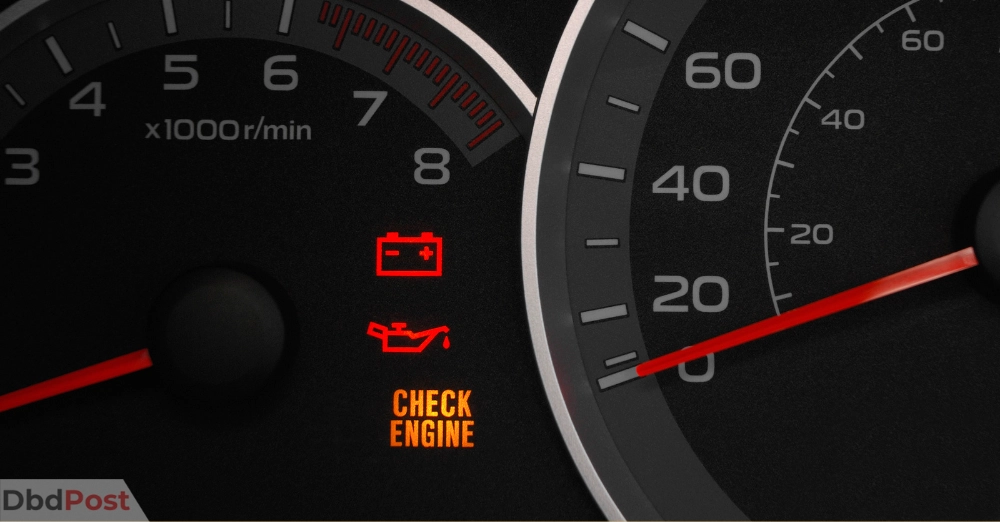The Dodge check engine light is an indicator that there is a problem with the car’s engine or emissions system. This light signals that the car’s onboard diagnostic system has detected a malfunction.
The check engine light is a crucial warning indicator that alerts drivers to potential problems with their car. The common causes for Dodge check engine warning light are Faulty oxygen sensors, Loose or damaged gas caps, Failing catalytic converters, and more.
This Dbd guide will provide all the necessary information on common causes of warning light and the process of resetting.
What does the Dodge check engine light mean?

The Dodge check engine light turns on when the car’s onboard diagnostic system detects a malfunction in the engine or emissions system.
This can be caused by various issues, such as a faulty oxygen sensor, a loose gas cap, problems in the ignition coil, or a failing catalytic converter. This can also be caused due to problems with the fuel tank and your low fuel economy.
A solid check engine light indicates a non-critical issue that should be addressed soon.
However, a flashing check engine light indicates a more severe problem that requires immediate attention.
It’s important to address the issue promptly to prevent further damage to the car. Failure to do so can lead to decreased gas mileage, reduced performance, and potentially more costly repairs.
Common causes of a Dodge check engine light

When the Dodge check engine light comes on, it can be caused by different issues related to the engine or emissions system.
- Faulty oxygen sensor
- Loose or damaged gas cap
- Failing catalytic converter
- Malfunctioning spark plugs or ignition coils
- Mass airflow sensor failure
- Engine vacuum leak
- Issues with the EVAP system
- Problems with the engine’s sensors or wiring
These issues can affect the car’s performance by causing it to run rough, misfire, or hesitate when accelerating. They can also reduce gas mileage, increase emissions, and potentially more severe damage if left unchecked.
For example, a faulty oxygen sensor can cause the car to burn more fuel than necessary, while a failing catalytic converter can lead to increased emissions and reduced power.
What to do when the Dodge check engine light comes on
When the check engine light is on, it’s essential to pay attention to all of the vehicle’s warning systems.
In many Dodge cars the VDC technology is one such system that can help redistribute torque to the wheels using sensor inputs.
In sport mode, VDC can operate with less aggressive brake-based stability control settings, while still providing the safety of dynamic stability control and the flexibility of AWD. [1]Dodge, “Vehicle Dynamic Control, … Continue reading
When the Dodge check engine light comes on, it’s important not to ignore it. Go for car maintenance as soon as you see the engine light flashing.
Ignoring the check engine light can lead to decreased fuel efficiency and reduced performance.
It can also mean severely damaged car’s engine and emissions system.

If the check engine light comes on, the first step is to check the gas cap. Make sure it’s not loose or damaged. If the gas cap is secure, consider taking the car to a mechanic to diagnose and repair it.
Moreover, driving with the check engine light on can affect the car’s performance. For example, a malfunctioning oxygen sensor can cause the car to burn more fuel than necessary. It can reduce gas mileage and increase emissions.
Driving with a failing catalytic converter can cause the car to stall or lose power, leading to potentially costly repairs.
How to reset the Dodge check engine light
After fixing the underlying issue, it is essential to reset engine light. This ensures that it does not reoccur and the car runs smoothly. Here’s a step-by-step guide on how to reset the Dodge check engine light:
Step 1: Turn off the engine
After fixing the issue causing the check engine light to turn on, turn off the engine and let it cool down for a few minutes.
Step 2: Locate the battery
Locate the car’s battery, which is usually under the hood or in the trunk.
Step 3: Disconnect the negative terminal
Loosen and remove the negative terminal on the battery using a wrench or a socket set. Ensure not to touch the positive terminal with the wrench or socket set.
Step 4: Wait for a few minutes
Leave the battery disconnected for a few minutes to allow any residual electricity in the system to discharge.

Step 5: Reconnect the negative terminal
Reconnect the negative terminal on the battery and tighten it securely.
Step 6: Start the engine
Start the engine and let it run for a few minutes to ensure everything works correctly.
Step 7: Check for any warning lights
Check the dashboard for any warning lights. The check engine light should be off, indicating that the system has been reset.
Related Stories
- Check this guide to know everything about Nissan Check Engine Light.
- Check this guide to know everything about Ford Check Engine Light.
- Check this guide on Mazda Check Engine Light – here.
- Find out everything about Jeep Tune Up cost with our guide.
- Click on this guide on GMC Check Engine Light to know everything about the issue.
FAQs
Can I continue to drive my Dodge with the check engine light on?
It is not recommended to continue driving your Dodge with the check engine light on. It can indicate a potentially serious problem that can cause damage to your car’s engine or emissions system.
In conclusion, the Dodge check engine light is a crucial warning system that alerts car owners to issues with their vehicle’s engine.
We hope our guide helped you with everything you need about the Dodge warning light.
- 107shares
- Facebook Messenger
About the author
DbdPost Staff is a team of writers and editors working hard to ensure that all information on our site is as accurate, comprehensive, and trustworthy as possible. Our goal is always to create the most comprehensive resource directly from experts for our readers on any topic.


![How Much Does it Cost to Wrap a Car in [year]? how much does it cost to wrap a car-feature image](https://dbdpost.com/wp-content/uploads/2021/09/how-much-does-it-cost-to-wrap-a-car-feature-image-150x150.jpg)
![How to Delete Shein Account? ([year] Edition) feature image-how to delete shein account](https://dbdpost.com/wp-content/uploads/2021/10/feature-image-how-to-delete-shein-account-150x150.png)
